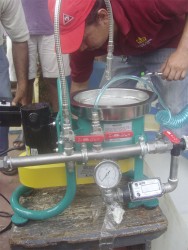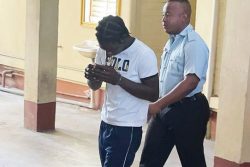The challenges to the country’s gold mining industry arising out of a drop in the price of gold and pressures to mitigate the environmental hazards linked to the use of mercury appear to be priority areas in the Guyana Mining School and Training Centre’s efforts to deliver an intensive regime of training for the country’s miners this year.
Stabroek Business has seen a schedule of training which the school plans to deliver this year and it includes the application of non-mercury gold recovery systems in the sector and improving the performance of sluice box operations. Both of these courses point to a seeming determination on the part of the Guyana Geology and Mines Commission (GGMC) to continue to reduce mercury pollution in the country’s gold-bearing areas.
This year’s list of 12 priority training areas outlined in a document released to this newspaper by the Mining School’s Administrative Coordinator John Applewhite-Hercules also lists courses in the planning of ‘Small Mine Operations’ and introductory, intermediate and advanced level training of prospectors for the industry and mine reclamation. This provides an indication that the sector is anticipating and gearing itself for expanded gold extraction activity this year.

The priority training areas also include health and safety and environmental impact management, which take account of the country’s domestic and international obligations to frontally address the health and safety challenges associated with working in the sector as well as the need to meet the environmental challenges associated with the commitments given by the Government of Guyana under the Minamata Convention.
Training for operators of excavators, heavy-duty equipment and hydraulic diesel mechanics which seeks to respond to the skills challenges confronting the industry round out the priority areas on which the Mining School plans to focus this year.
Since its establishment in 2012, the local Mining School has already executed training for miners in a range of sector-related areas including introductory level training for prospectors, fall protection, transportation of dangerous goods, workplace hazards and safe and efficient blasting in open cut pits.
Between mid-August 2013 and the end of last year a total of 563 miners benefited from training provided by the Mining School.
Meanwhile, the GGMC’s mining school has outlined its planned upgrading operations that will target four of its training and research locations. The Mining School says that during 2015 it will install and network 50 desktop computers “equipped with software” at its Linden Research and Development Facility and install and equip 25 lap top computers with software and network facility at its Kingston Multi Complex Training Centre. The Mining School’s Field School site at Omai is to benefit from an overall upgrading exercise that will include the installation of Field School infrastructure and the establishment of non-mercury gold-recovery demonstration equipment that will increase recovery rates and sampling equipment and devices.
The local Mining School’s promised intensified training regime apart, the country’s gold-mining sector is also set to benefit from advanced training techniques and sector technology with the arrival here of significant expatriate gold-mining operations. In 2013 the Canadian company Guyana Goldfields told Stabroek Business that local employees recruited to work with its operations will benefit from a combination of local and overseas training aimed at properly preparing them to work in the company’s underground operations.
The local Mining School benefits from high-profile cooperation and support agreements with the World Wildlife Fund (WWF), the Canada-based College of the North Atlantic and the University of Newfoundland Fisheries and Marine Institute. These cover mining, oil and gas, marine environment, safety, ocean technology, fisheries and ocean resources management. However, the local school’s five-year strategic plan still points to fluctuating gold prices, technology, equipment, capacity and economic sustainability limitations as possible threats to the School’s growth that give rise to the need for subsidies. Nonetheless, it focuses on seeking to equip mining sector workers to emulate the best practices in the industry.









